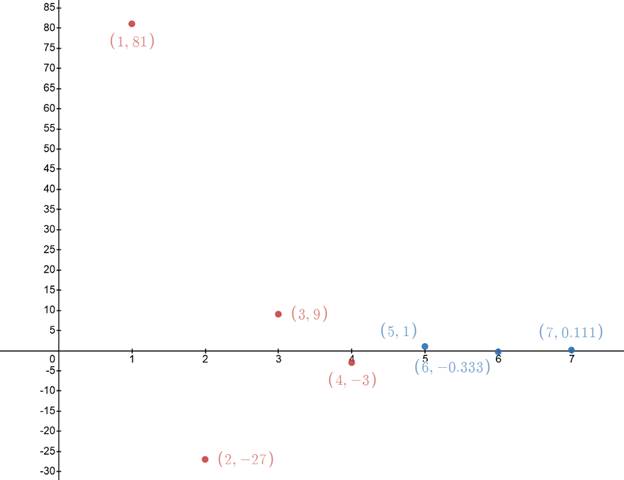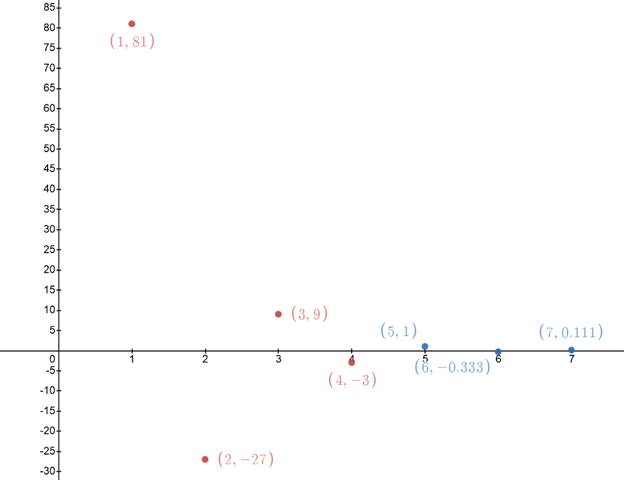
Concept explainers
To write next three terms of the geometric sequence:
And also plot the graph of the sequence.
Answer to Problem 21E
The next three terms of given geometric series are: 1, 
Explanation of Solution
Given:
The given geometric sequence is:
Concept Used:
- In a geometric sequence, the ration between each pair of consecutive terms is the same, this ratio is called the common ratio.
- Each term of a geometric series is found by multiplying the previous term by the common ratio.
Calculation:
To write next three terms of the geometric sequence:
First find the common ratio of the sequence by dividing second term by first, as
Thus, common ration of the given geometric sequence is
Thus, next term of
Similarly, next term of 1 is:
And, next term of
Thus, next three terms of given geometric series are: 1,
Now, to plot the graph of given sequence, first make a table of representing terms, say
| n | 1 | 2 | 3 | 4 | 5 | 6 | 7 |
| 81 | 9 | 1 |
Now, using this table plot the graph of the given sequence by plotting the coordinates in above table:
Thus, graph of the sequence is represented by blue and red dots, as

Chapter 6 Solutions
BIG IDEAS MATH Integrated Math 1: Student Edition 2016
- 5). The dose to the breast was 120 mGy find the entire body dose represented in rad?arrow_forward1000 x= 800mGy to body X= = rad 7). If EI=300, TEI=500 with mAs = 20 and you want to decrease the kV by 15% then 0.8 Gy what is the new mAs value to set DI=0? =0% 100-00 Dorad 8) A te dose of rem w kV? 2 tom i sv 4sv 48rem to thyr. KV+ I formula K In = Fox2 kV (1979) (48 rem = 8.2 = 16. SVx 100 160oren-body 1600.0.03=X I M M Earrow_forwardCan you solve question 3,4,5 and 6 numerical method use all data i given to you and teach mearrow_forward
- 8 If f(x + y) = f(x)f(y) and Σ f (x) = 2, x, y = N, x=1 where N is the set of all natural number, then the f(4) value of is. f(2)arrow_forward- Consider the following system of linear equations in the variables a,b,c,d: 5a-3b 7c - 2d = 2 2ab 2c+ 5d = -3 → (*) 4a 3b 5d = 3 6a b+2c+ 7d = −7 (a) Solve the system (*) by using Gauss elimination method. (b) Solve the system (*) by using Cramer's rule method.arrow_forwardSolve for a 25 55 30 a=?arrow_forward
- vide 0. OMS its 150MAS 40k 300mts 46KV 4). A technique is taken with 100 mA, 200 ms, 60 kV and produces 200 mSv. Find the intensity in rem when this technique is changed to 200 mA, 400 ms, 69 kV? nd 5). The dose to the body was 200 mSy. Findarrow_forwardGenesis Ward #9) A good exposure is taken using a technique of 12 mAs, 200 cm SSD,40kv, table top, and produces an EI value of 400 with a TEI value of 500. Find the new mAs value required to set DI=0, if a 100 cm SSD,34kV and a 6:1 grid were substituted. 12 MAS, 200cm SSD, 40kv E1 = 400 TEL = 500 of a radiograph was 100 mSv with a technique of: 10 mAs, 180 kV at 200 cm and 2 IV at 00 cm using a 5:1 grid then find thearrow_forwardExplain the key points of 11.5.2arrow_forward
 Discrete Mathematics and Its Applications ( 8th I...MathISBN:9781259676512Author:Kenneth H RosenPublisher:McGraw-Hill Education
Discrete Mathematics and Its Applications ( 8th I...MathISBN:9781259676512Author:Kenneth H RosenPublisher:McGraw-Hill Education Mathematics for Elementary Teachers with Activiti...MathISBN:9780134392790Author:Beckmann, SybillaPublisher:PEARSON
Mathematics for Elementary Teachers with Activiti...MathISBN:9780134392790Author:Beckmann, SybillaPublisher:PEARSON
 Thinking Mathematically (7th Edition)MathISBN:9780134683713Author:Robert F. BlitzerPublisher:PEARSON
Thinking Mathematically (7th Edition)MathISBN:9780134683713Author:Robert F. BlitzerPublisher:PEARSON Discrete Mathematics With ApplicationsMathISBN:9781337694193Author:EPP, Susanna S.Publisher:Cengage Learning,
Discrete Mathematics With ApplicationsMathISBN:9781337694193Author:EPP, Susanna S.Publisher:Cengage Learning, Pathways To Math Literacy (looseleaf)MathISBN:9781259985607Author:David Sobecki Professor, Brian A. MercerPublisher:McGraw-Hill Education
Pathways To Math Literacy (looseleaf)MathISBN:9781259985607Author:David Sobecki Professor, Brian A. MercerPublisher:McGraw-Hill Education





